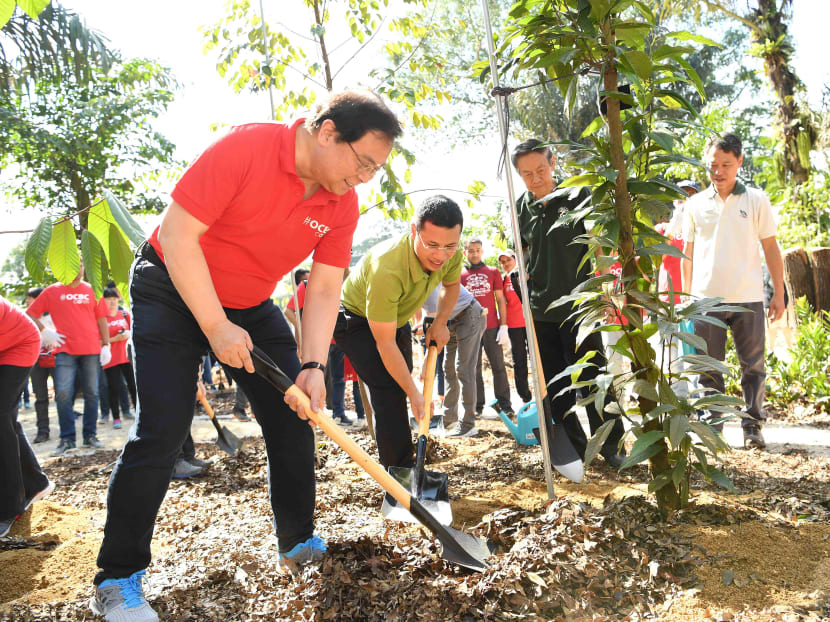OCBC invests S$4 million to build high-tech research forest at Singapore Botanic Gardens
SINGAPORE — Picture 2,000 endangered rainforest trees from 200 species growing in a space the size of two football fields, feeding data to sensors monitoring their growth, health and environment.

From left: Mr Samuel Tsien, chief executive officer of OCBC Group, Mr Desmond Lee, Minister for Social and Family Development, and Professor Leo Tan, chairman of the Garden City Fund, planting a Shorea Gratissima tree at the site of the OCBC Arboretum.
SINGAPORE — Picture 2,000 endangered rainforest trees from 200 species growing in a space the size of two football fields, feeding data to sensors monitoring their growth, health and environment.
Using the data, researchers could guide the restoration of South-east Asia’s tropical forests.
To realise this vision, the National Parks Board (NParks) and OCBC bank announced on Saturday (July 20) that they are jointly setting up an arboretum — a garden of trees.
The project is said to be the first in the region to deploy Internet of Things technology in this way.
The space, to be named OCBC Arboretum, will be located in the Singapore Botanic Gardens, on a 2ha parcel of land within its 8ha extension along Gallop Road.
Beside it is a historical building — Singapore’s first black-and-white bungalow, which will be repurposed to house a “knowledge centre” for tree conservation.
The opening date for this research space has not been announced.
OCBC will plough S$4 million into the arboretum and the centre, which will be its most significant contribution to NParks to date. In 2017, it put S$250,000 into a five-year habitat enhancement project at Coney Island Park in Punggol Promenade.
PLANTING FIRST TREES
The new project will collect data that will help arborists and ecologists understand the conditions required for the healthy growth of dipterocarp trees, which are the “backbone” of South-east Asian tropical forests, NParks and OCBC said in a joint press release.
The hardwood trees, which has more than 500 described species, grow to be some of the tallest trees in forests, comprising up to 50 to 80 per cent of the forest canopy in the region, they added.
This makes dipterocarps vital in shaping the landscape and creating a habitat for other plants and wildlife.
On Saturday, the ceremony to launch the project was attended by attended by Mr Desmond Lee, Minister for Social and Family Development, and OCBC Group’s chief executive officer Samuel Tsien.
The first 160 trees were planted, and this first batch of trees contain 54 species.
Commenting on the significance of the arboretum, Mr Tsien said that many of the tree species at the arboretum are “critically endangered” due to deforestation and natural loss.
“By planting a living collection of trees and investing in technology to understand the conditions for better growth, we hope to ensure the survival of these trees and mitigate the impact of climate change,” he said.
Professor Leo Tan, chairman of NParks-registered charity Garden City Fund, said that the new-age arboretum will allow an analysis of “tree management scenarios”, which will help arborists make timely interventions and carry out the necessary mitigating measures to allow the trees to thrive.
Technologies to be used in the arboretum include a remote sensing and modelling tool called Light Detection and Ranging (Lidar), which will use lasers to rapidly create high-resolution three-dimensional models of trees.
The arboretum will also be equipped with special multi-spectral imaging cameras, which will capture the different wavelengths of light that are reflected off features on the tree.
This will allow computers to detect problems that are not even discernible by the naked eye yet, NParks and OCBC said.








